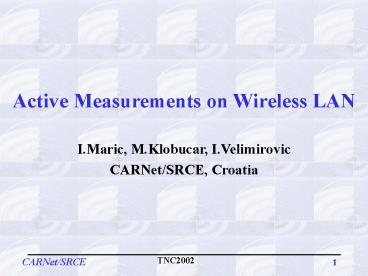Active Measurements on Wireless LAN - PowerPoint PPT Presentation
1 / 14
Title:
Active Measurements on Wireless LAN
Description:
Since one of the main goals of the testing was to compare two different devices ... SNMP based tool for collecting data (ifInOctets, ifOutOctets MIB variables) ... – PowerPoint PPT presentation
Number of Views:30
Avg rating:3.0/5.0
Title: Active Measurements on Wireless LAN
1
Active Measurements on Wireless LAN
I.Maric, M.Klobucar, I.Velimirovic CARNet/SRCE,
Croatia
2
Project goal(s)
- To test real transport characteristics of a given
wireless network (IEEE 802.11b) using active
measurement - To compare two different devices included in
implemented network
- Limitations
- Measurement took place on the network that was
already implemented and operational - Encryption was enabled on all devices
3
Characteristics of tested wireless devices
- Device A Cisco Aironet BRI340 Series 11Mbps WAN
Ethernet Multipoint Bridge, 128 bits encryption
(WEP), in point-to-point operative mode - Device B Lucent WavePOINT II Wireless Bridge
Orinoco ROR, 64 bits encryption (WEP),
Point-to-multipoint implemented with one
omni-directional antenna on Master device
Since one of the main goals of the testing was to
compare two different devices included in
implemented network, it was clear that devices
should be compared only when operating in the
same operative mode.
4
Test network scheme (device A)
5
Test network scheme (device A)
6
Link distances FER - FKIT 620 m FKIT - PRAVO
390 m FKIT - IMO 130 m FKIT - ARHIV 100 m
7
Traffic generators and measurement technique
- Traffic generators
- Linux based standard PCs (Intel 486)
- Software traffic generator (mgen) UDP packets,
using different packet size - Max speed of generated traffic 8.5 Mbps
- Measurement technique
- SNMP based tool for collecting data (ifInOctets,
ifOutOctets MIB variables) - Sample period 1 minute
- Data stored in database (mSQL lightweight
database)
8
Expected results
9
Results
- Measurements were done in 3 separated tests as
follows - Laboratory test (device A)
- Test on site, point-to-point operative mode
(device A) - Test on site, point-to-point point-to-multipoint
operative modes (device B)
10
Test in lab (device A)
11
Test on site (device A)
12
Test on site (device B)
Testing results for device B, in three different
operative modes point-to-point,
point-to-multipoint 1-2 (one Master and two Slave
devices) and point-to-multipoint 1-3 (one Master
and three Slave devices)
13
Comparison of two devices
Maximum transmission speed (Mbps) for different
packet size of generated traffic (100, 200, 500,
1000 and 1400 bytes) for devices A and B.
14
Future work
- Focus on time parameters (round trip time,
response time, etc.) in order to see what are the
limitations for time-sensitive applications like
IP multicast, high quality voice and video over
IP, etc. over wireless links - In order to test links on application level,
some end-to-end testing will be performed, rather
than node-to-node, as it was done in this
measurements - Interoperability between different manufacturers
is also an interesting topic for future research.































